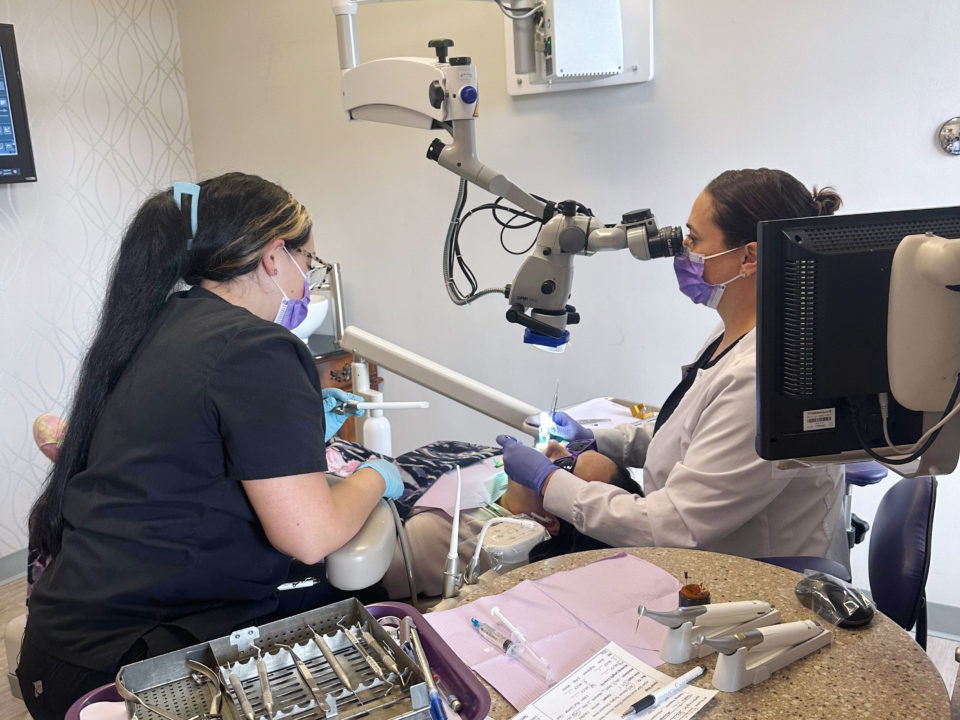
What Are Alternatives To A Root Canal?
December 30, 2022
Does Getting A Root Canal Hurt?
January 25, 2023
What Are Alternatives To A Root Canal?
December 30, 2022
Does Getting A Root Canal Hurt?
January 25, 2023While root canal treatment has a very high success rate, in some cases, the tooth may require endodontic retreatment or surgery later. If you’re wondering what are the symptoms of a failed root canal in a treated tooth, even years later, you should contact an endodontist, like our team at Innovative Endodontics, for endodontic retreatment to save your tooth.
What Causes a Failed Root Canal?
During a root canal, the doctor clears out the infected or inflamed nerve and pulp from inside the tooth. They will also disinfect the interior of the tooth to ensure that no bacteria remain behind. Successful root canals leave the canals completely clean, even into the deepest reaches of the tooth. However, some people have teeth that have hidden areas, extremely narrow canals, or intricate anatomy that make it impossible for the endodontist to completely clean and disinfect.
According to the Cleveland Clinic, 98% of root canals are successful. However, because the two percent does exist, patients need to know about the signs and causes of failure.
In most cases of a failed root canal, healing did not take place as expected because bacteria either remained in the tooth or reentered the root canals later. Some common causes of this include:
- Intricate internal anatomy with areas of the canals
- Unusually narrow root canals
- Extra canals in your tooth that housed bacteria after the procedure
- Delay in getting a crown
The above conditions are exceedingly rare, especially today, with modern imaging equipment and tools. However, root canal failure is still possible.
Additionally, future damage to the tooth may require you to seek endodontic retreatment or surgery. Decay, breaks, or cracks in the tooth or the crown could introduce new bacteria and cause an infection. These conditions will have similar symptoms to a failed root canal but occur much later after the procedure.
What Are the Symptoms of a Failed Root Canal?
Some of the most common symptoms of a failed root canal are the same as those that led you to seek treatment in the first place. After your procedure, any of the following signs should prompt you to call your endodontist:
- Pain, especially if it subsided and returned
- Swelling at the gums
- Sinus discomfort without congestion or other sinus infection-related symptoms
- Boil on the gums
- Drainage of pus around a tooth
The above signs relate to a new infection in the tooth. You need treatment to remove the infection and stop it from spreading.
What Happens If You Don’t Treat a Failed Root Canal?
Without treatment, you could have that infection spread. The risks of spreading infection from a tooth include a lost tooth or systemic problem that may require hospital care. Take any symptoms of a failed root canal seriously and get treatment as soon as possible.
How Does an Endodontist Treat a Failed Root Canal?
An endodontist will treat a failed root canal with either surgery or endodontic retreatment, depending on several factors, such as the internal anatomy of your tooth, present restorative materials, and other findings.
Endodontic Retreatment
The most common option for treating a failed root canal is endodontic retreatment. The endodontist removes everything in the tooth from the original root canal and retreats the area to get rid of bacteria. As with a root canal, endodontic retreatment finishes with disinfecting the interior of the tooth, filling the tooth’s canals, and sealing the tooth.
However, if the initial root canal failed due to difficult-to-reach portions of the root, the endodontist may recommend surgery.
Endodontic Surgery
Endodontic surgery accesses the tooth’s root canals from the end of the root. To reach this area, the endodontist must make small incisions in the gums and clean out the area of infection, making surgery a more invasive procedure than endodontic retreatment or root canal. Surgery may serve as a standalone solution or paired with retreatment to correct a failed root canal.
During an apicoectomy, the endodontist makes small incisions into the gums and removes infected or inflamed tissue that remains at the root end of the tooth after a root canal. This procedure is one of many different forms of endodontic surgery the doctor may perform.
If your endodontist recommends surgery, it is because non-surgical intervention will not suffice to save your tooth. Recovery time from surgery takes longer than root canal treatment because the bone at the base of the tooth must heal, but discomfort tends to be minor after surgery.
Can a Patient Help Prevent Root Canal Failure?
While many of the causes of root canal failure come from unusual internal anatomy in the tooth, there is one thing that a patient can do to help prevent problems.
If your endodontist recommends that you get a crown on a treated tooth, do so within the specified time frame. Teeth that have had root canal treatment are slightly weaker due to drilling out part of the material. For the front teeth, this does not pose much of a problem. However, the molars have more pressure on them during biting. So, you will need a crown to provide the extra strength the tooth needs to avoid damage.
Waiting too long to get a crown puts your tooth at risk of cracking or cavity development. Once you finish the portion of the root canal treatment with your endodontist, contact your dentist to get a crown, if recommended.
Other things that you can do to prevent future damage to a treated tooth include protecting the tooth from decay and physical damage, such as:
- Wear sports guards during contact sports
- Do not use your teeth to break open packages or as other tools
- Keep up with regular dental appointments
- Maintain good oral hygiene habits by brushing and flossing twice a day
- Get treatment promptly if you notice any discomfort in your treated tooth
Get Endodontic Retreatment for Failed Root Canals and More at Innovative Endodontics
If you have symptoms of a failed root canal, contact our office right away at Innovative Endodontics. We’ll provide you with the endodontic retreatment you need to prevent future infections and help you to find relief from the pain. With prompt treatment, you don’t have to have your tooth pulled. Come see us at Innovative Endodontics and see how we change the reputation of root canals one patient at a time.




